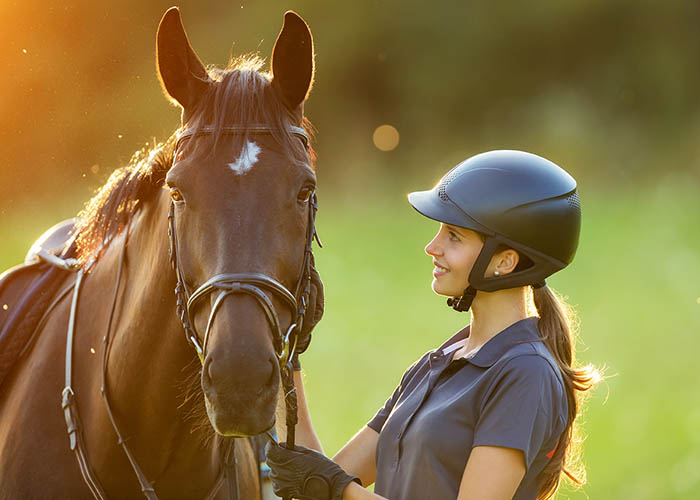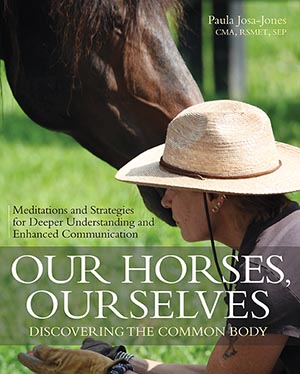
For many equestrians, methodically cleaning stalls transcends into an act of unintentional meditation. Your mind clears and you can focus only on the job at hand which in turn has calming effects. However, the power of spending time around horses goes far beyond the meditative value of chores. In this blog post, we explore the connection between horses and mindfulness, while taking a look at how approaching our equestrian activities with mindfulness and intent can improve our relationship with not only our horses but also with ourselves.
What is Mindfulness?
Before mindfulness connected with horses can be examined, it’s important to understand what mindfulness is on its own. According to Tom Bassarear, the founder of the Monadnock Mindfulness Practice Center (MMPC) in Keene, NH, “Mindfulness is the bringing of one’s full attention to the present moment.” Many of the practice members at MMPC use different types of meditation (breathing, walking, etc.) to deepen their practice of mindfulness.
“The practice of mindfulness enhances clarity, deepening our understanding of [the] self and others while opening the capacity to make a positive difference in the world around us,” Tom explains. “Multiple studies of the benefits of mindfulness meditation have demonstrated that regular practice can enrich daily living. People who come to the Center report that developing a meditation practice helps to deal with challenging stresses and anxieties, including parenting, a demanding job, a serious illness, or loss of a loved one.”
Mindfulness can come in many forms. It can be an expanded guided meditation practice or as simple as slowing down and striving to pay more attention to the world around you. Mindfulness encourages you to disengage from the media and take in the sights and sounds of the moment while vacating your mind from problematic thinking, stress, and worry.
The benefits of mindfulness are seemingly endless and continue to grow as research increases. According to the Mayo Clinic, “Meditation and mindfulness has been studied in many clinical trials. The overall evidence supports the effectiveness for various conditions, including: stress, anxiety, pain, depression, insomnia, and high blood pressure (hypertension). Preliminary research indicates that meditation can also help people with asthma and fibromyalgia.”
The Equestrian Connection
So, what does this have to do with horses? When we are in the barn, stress, unwelcome thoughts and anxiety tend to melt away. Instead, time with our horses encourages us to be in the moment and focus on our link to these incredible animals. As human consciousness evolves, our connection with ourselves deepens and we are able to realize the incredible connection between thought-free awareness and our equine counterparts.
Because horses live entirely in the present, they are a living study of mindfulness. Their acute ability to be in the moment allows them to pick up on our subtle body language cues and emotions. Horses often mirror our feelings and if we are displaying stress, nervousness, or strong emotions, they tend to display the same. This equine unbiased feedback gives us the ability to see ourselves better and challenge us to steady ourselves.
Once equestrians begin to practice mindfulness themselves, the results radiate outward to others. As you and your horse begin to forge a deep, peaceful connection with one another, you can communicate more clearly and without fear. Many people discover that they are able to show more patience and fully listen to their horse’s needs once they have discovered the power of living in the moment and paying attention to the world around them.
Many equestrian-based programs are using mindfulness training and the power of horses to help humans become more in tune with their emotions and heal from past traumas. Equine-assisted and equine-facilitated therapies focus on the shared consciousness of horse and rider or handler to expand awareness and establish a calm and relaxed feeling of safety. Equine-guided therapies that focus on the mindfulness movement and connection with horses have proven to be effective in recovering from post traumatic stress disorder (PTSD), anxiety, addiction, and many more mental health challenges.
Charles de Kunffy, USDF Hall of Fame master horseman, author, clinician, and judge, summed it up perfectly in his journals, “Horses forge the mind, the character, the emotions and inner lives of humans. People can talk to one another about all these things and remain distanced and lonesome. In partnership with a horse, one is seldom lacking for thought, emotion and inspiration. One is always attended by a great companion.”
Exercises in Mindfulness
While the act of being with our horses encourages us to be in the moment, it makes sense to practice mindfulness both in the barn and in our everyday lives. In Our Horses, Ourselves: Discovering the Common Body, dancer, choreographer, and passionate equestrian Paula Josa-Jones combines her love of movement and meditation with the inspirational power of horses. In this book, she showcases how guided meditations and movement exercises can help equestrians achieve a soft, fluid connection with our equine partners.
Paula’s teachings incorporate 65 mounted and unmounted exercises, as well as strategies to build on your mindfulness practice. She explains, “The result is we not only have a closer, more intuitive connection with our horses, we are more trustworthy, more comfortable in our own skin, and better prepared to act with balance, sensitivity, and kindness in all our relationships.”
Try it out for yourself! Try this mounted meditation that will increase the communication between you and horse. It also helps you to melt into the saddle, soften your seat, and relax in conjunction with your horse. Once you have practiced this mindfulness exercise, try it whenever you feel tension building in either you or your horse.

Opening With Heart Meditation
PURPOSE: Imagine bringing a quality of openness and vulnerability into your riding and your time with your horse. How would that feel in your body? In your mind?
Practice this meditation:
1. As you breathe, feel your lungs surrounding and “holding” your heart. Visualize the heart expanding into this cradling support. Picture your horse’s heart enfolded by his lungs.
2. Can you bring this quality of nurturance into your body and mind as you ride? As your legs drape on the sides of the horse, can you imagine them like another pair of lungs, surrounding and supporting the heart of the horse?
3. Instead of looking for what is wrong, what needs to be improved, or some difficulty with your horse, focus on what is pleasurable: your legs receiving the warmth of the horse’s sides, the undulating sensation of your hips in the saddle, the softness of his eye.
4. While you are riding, try saying out loud, “How can I help?” and notice how that changes the conversation between you and your horse.
This excerpt from Our Horses, Ourselves: Discovering the Common Body by Paula Josa-Jones is reprinted with permission from Trafalgar Square Books (www.horseandriderbooks.com).
Now, more than ever, is a time to truly connect with our horses and be in the moment. Many of us are staying home at the moment due to the COVID-19 crisis, and mindfulness with horses helps us cope with the changes and stresses of this unprecedented situation. The next time you head to the barn, pay close attention to the sights, smells, and sounds of your horse. As you groom your horse, feel their soft coat and the rise and fall of their breath. Soon, you’ll also be able to feel your shoulders loosen, the stress fall away, and a general feeling of contentment.

Really love this article, thank you so much for writing and sharing it! Mindfulness and proper breathing are our most important tools and aids! They are so important always and especially when riding, grooming, and doing everything with our horses! Would love to see more articles and I will read Paula’s book – thank you!
Great Article… got me inspired in a new project